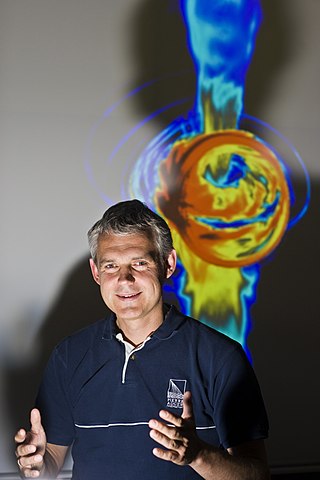
A black hole is a region of spacetime where gravity is so strong that nothing, including light and other electromagnetic waves, has enough energy to escape it. The theory of general relativity predicts that a sufficiently compact mass can deform spacetime to form a black hole. The boundary of no escape is called the event horizon. Although it has a great effect on the fate and circumstances of an object crossing it, it has no locally detectable features according to general relativity. In many ways, a black hole acts like an ideal black body, as it reflects no light. Moreover, quantum field theory in curved spacetime predicts that event horizons emit Hawking radiation, with the same spectrum as a black body of a temperature inversely proportional to its mass. This temperature is of the order of billionths of a kelvin for stellar black holes, making it essentially impossible to observe directly.
A strange star is a hypothetical astronomical object, a quark star made of strange quark matter.
A gravastar is an object hypothesized in astrophysics by Pawel O. Mazur and Emil Mottola as an alternative to the black hole theory. It has usual black hole metric outside of the horizon, but de Sitter metric inside. On the horizon there is a thin shell of matter. The term "gravastar" is a portmanteau of the words "gravitational vacuum star".
In fluid mechanics and astrophysics, the relativistic Euler equations are a generalization of the Euler equations that account for the effects of general relativity. They have applications in high-energy astrophysics and numerical relativity, where they are commonly used for describing phenomena such as gamma-ray bursts, accretion phenomena, and neutron stars, often with the addition of a magnetic field. Note: for consistency with the literature, this article makes use of natural units, namely the speed of lightand the Einstein summation convention.

An astrophysical jet is an astronomical phenomenon where outflows of ionised matter are emitted as extended beams along the axis of rotation. When this greatly accelerated matter in the beam approaches the speed of light, astrophysical jets become relativistic jets as they show effects from special relativity.

PSR J0737−3039 is the first known double pulsar. It consists of two neutron stars emitting electromagnetic waves in the radio wavelength in a relativistic binary system. The two pulsars are known as PSR J0737−3039A and PSR J0737−3039B. It was discovered in 2003 at Australia's Parkes Observatory by an international team led by the Italian radio astronomer Marta Burgay during a high-latitude pulsar survey.
A dark-energy star is a hypothetical compact astrophysical object, which a minority of physicists think might constitute an alternative explanation for observations of astronomical black hole candidates.

The Max Planck Institute for Gravitational Physics is a Max Planck Institute whose research is aimed at investigating Einstein's theory of relativity and beyond: Mathematics, quantum gravity, astrophysical relativity, and gravitational-wave astronomy. The institute was founded in 1995 and is located in the Potsdam Science Park in Golm, Potsdam and in Hannover where it closely collaborates with the Leibniz University Hannover. Both the Potsdam and the Hannover parts of the institute are organized in three research departments and host a number of independent research groups.
The following outline is provided as an overview of and topical guide to black holes:

Remo Ruffini. He is the Director of ICRANet, International Centre for Relativistic Astrophysics Network and the President of the International Centre for Relativistic Astrophysics (ICRA). Ruffini initiated the International Relativistic Astrophysics PhD, a common graduate school program of several universities and research institutes for the education of theoretical astrophysicists. He is the Director of the Erasmus Mundus IRAP PhD program. He has been Professor of Theoretical Physics at the University of Rome "Sapienza" from 1978 to 2012.
The Hans A. Bethe Prize, is presented annually by the American Physical Society. The prize honors outstanding work in theory, experiment or observation in the areas of astrophysics, nuclear physics, nuclear astrophysics, or closely related fields. The prize consists of $10,000 and a certificate citing the contributions made by the recipient.

Tsvi Piran is an Israeli theoretical physicist and astrophysicist, best known for his work on Gamma-ray Bursts (GRBs) and on numerical relativity. The recipient of the 2019 EMET prize award in Physics and Space Research.

Computational astrophysics refers to the methods and computing tools developed and used in astrophysics research. Like computational chemistry or computational physics, it is both a specific branch of theoretical astrophysics and an interdisciplinary field relying on computer science, mathematics, and wider physics. Computational astrophysics is most often studied through an applied mathematics or astrophysics programme at PhD level.
In astronomy, blitzars are a hypothetical type of neutron star, specifically pulsars that can rapidly collapse into black holes if their spinning slows down. Heino Falcke and Luciano Rezzolla proposed these stars in 2013 as an explanation for fast radio bursts.

Heino Falcke is a German Dutch professor of radio astronomy and astroparticle physics at the Radboud University Nijmegen. He was a winner of the 2011 Spinoza Prize. His main field of study is black holes, and he is the originator of the concept of the 'black hole shadow'. In 2013, a team under his lead earned a 14 million euro research grant from the European Research Council to further studies of black holes. In 2019, Falcke announced the first Event Horizon Telescope results at the EHT Press Conference in Brussels.

The first direct observation of gravitational waves was made on 14 September 2015 and was announced by the LIGO and Virgo collaborations on 11 February 2016. Previously, gravitational waves had been inferred only indirectly, via their effect on the timing of pulsars in binary star systems. The waveform, detected by both LIGO observatories, matched the predictions of general relativity for a gravitational wave emanating from the inward spiral and merger of a pair of black holes of around 36 and 29 solar masses and the subsequent "ringdown" of the single resulting black hole. The signal was named GW150914. It was also the first observation of a binary black hole merger, demonstrating both the existence of binary stellar-mass black hole systems and the fact that such mergers could occur within the current age of the universe.
Stuart Louis Shapiro is an American theoretical astrophysicist, who works on numerical relativity with applications in astrophysics, specialising in compact objects such as neutron stars and black holes.
Reva Kay Williams is a theoretical astrophysicist. She is the first person to successfully work out the Penrose process using Einstein's Theory of Relativity to extract energy from black holes. Also, she is the first Black American woman to earn a PhD in theoretical astrophysics. Her work focuses on general relativistic astrophysics.

Ramesh Narayan is an Indian-American theoretical astrophysicist, currently the Thomas Dudley Cabot Professor of the Natural Sciences in the Department of Astronomy at Harvard University. Full member of the National Academy of Sciences, Ramesh Narayan is widely known for his contributions on the theory of black hole accretion processes. Recently he is involved in the Event Horizon Telescope project, which led in 2019 to the first image of the event horizon of a black hole.
Monika Mościbrodzka is a Polish astrophysicist who is a professor at Radboud University Nijmegen. She is an expert in general relativistic plasma dynamics and numerical astrophysics. She was part of the Event Horizon Telescope team who contributed to the first direct image of a black hole, supermassive black hole M87*. She was awarded the 2022 Dutch Research Council Athena Prize and the 2023 Royal Astronomical Society Eddington Medal.









